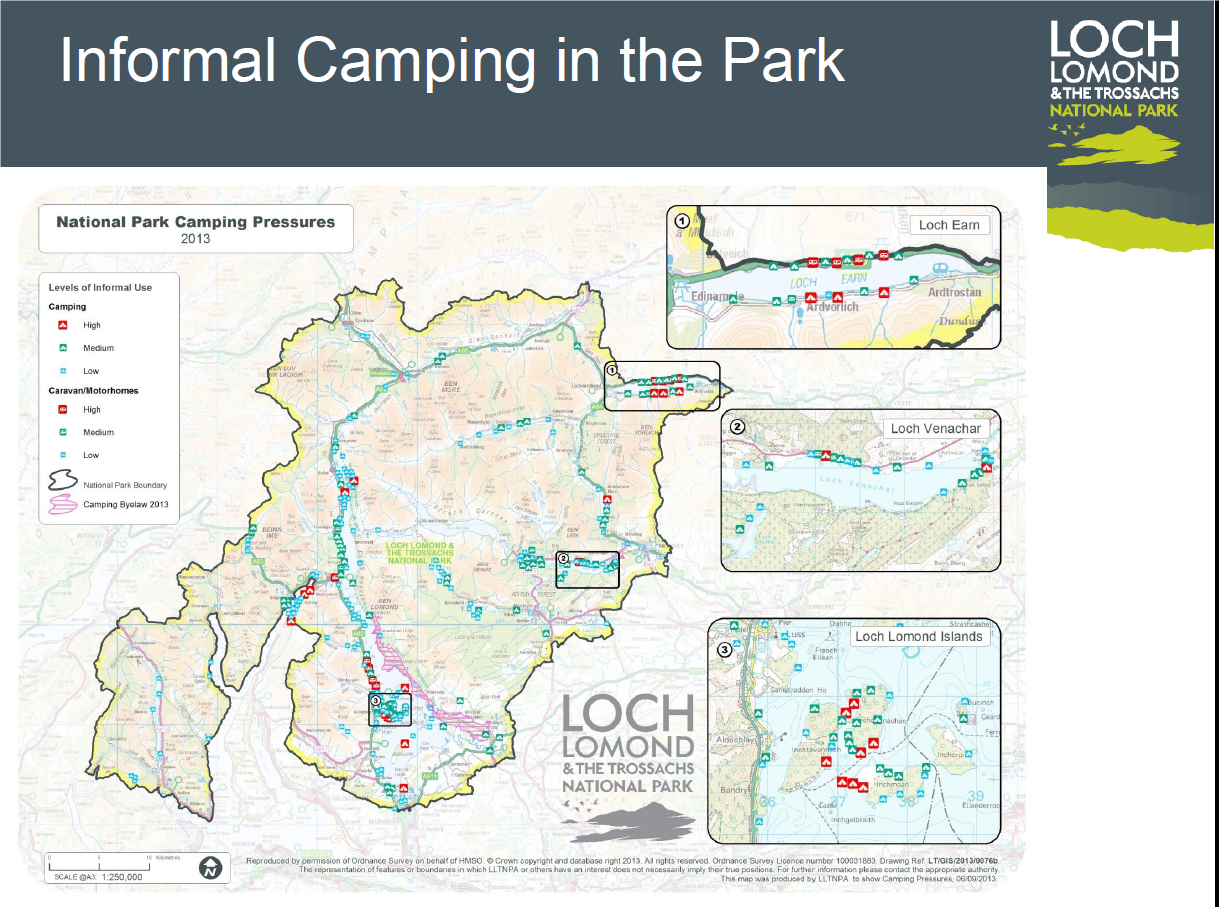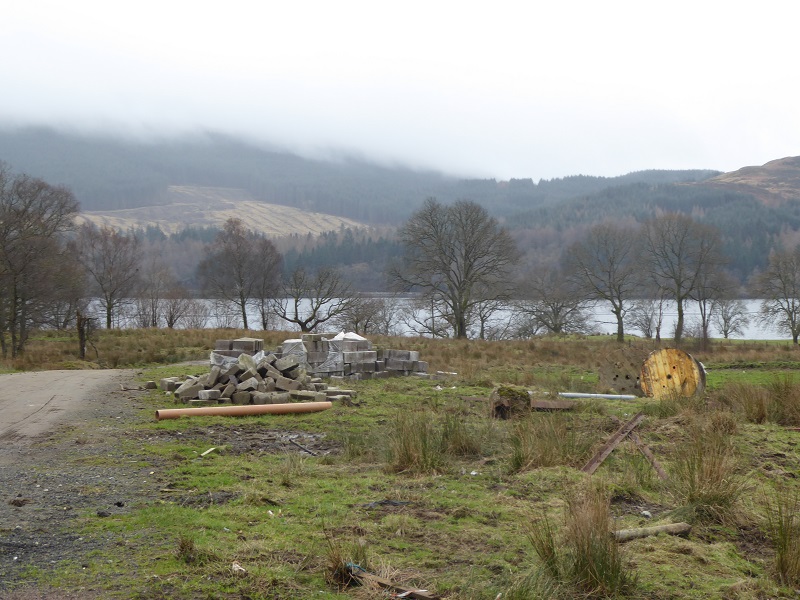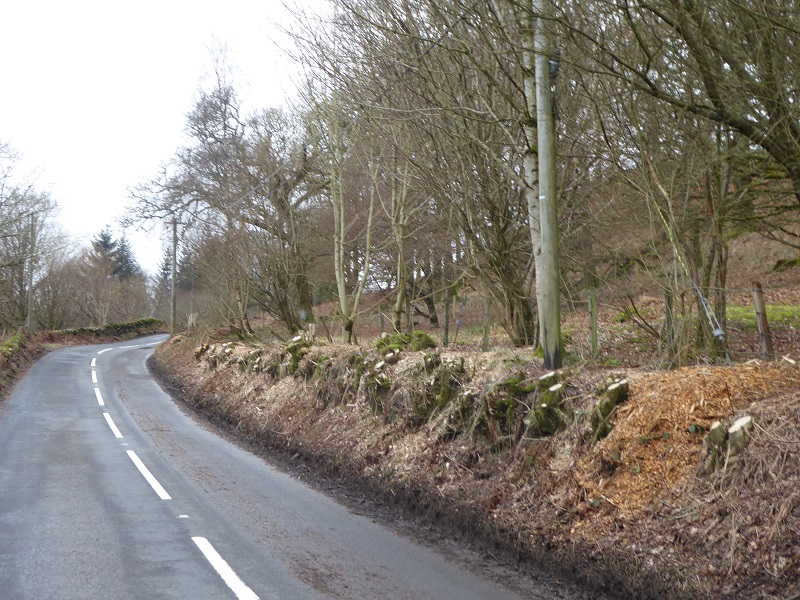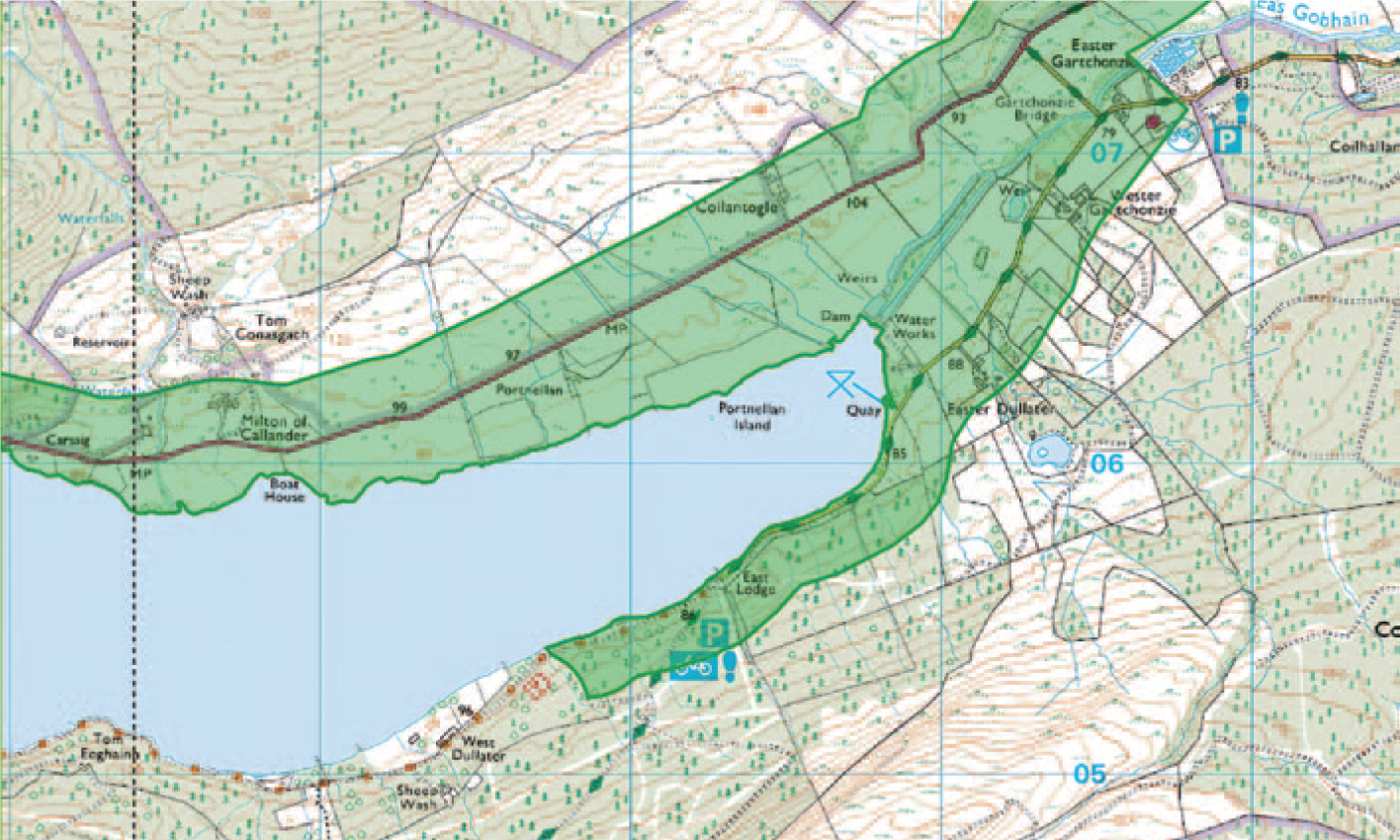
Today probably marks the most retrograde in the history of access to land in Scotland since the Trespass Scotland Act of 1865 as the camping byelaws come into force. When even Radio 3, not renowned for covering the great outdoors, announces on its 7.30 news headlines that campers in one of Britain’s prime beauty spots will be guilty of a criminal offence with a fine up to £500, the wider public may start to realise what is happening: that the right to peaceably enjoy the countryside is being removed by a National Park whose statutory purpose is to promote the right to enjoy the countryside.
As I am writing this there is a debate on Radio Scotland about the new £200 penalties for using a mobile phone while driving a car – using a mobile can kill people but is a civil offence. Camping according to the Scottish Outdoor Access Code and harming no-one in the best places to camp in the National Park is now a criminal offence with a fine of up to £500. How is that right or just?
The URL for the Loch Lomond and Trossachs National Park media release announcing the implementation of the byelaws (see here) says it all. The Park welcomes campers………….by banning them! The rest of the release is the usual parkspeak…………………………
Parkspeak
“Between March and September, people keen to camp or stay overnight in a motorhome or campervan at one of the many popular and picturesque lochshore locations throughout the Park, can do so by buying a camping permit or booking a pitch at a campsite.”
Comment. Not true. A large proportion of the lochshores have no provision for camping at all and there are only 20 permits for campervans for all four management zones.
Parkspeak
““The camping management zones are focused around the national park’s busiest lochshore locations which attract very high numbers of campers year on year.”
Comment. Lie. The management zones includes lochs where there was very little camping, like Loch Arklet, and other areas, where again there is very little camping, as is clearly shown by the Park’s own data (above) presented to the LLTNPA Board in 2013 but then suppressed.
Parkspeak
“This volume, combined with the antisocial behaviour of a minority of campers over a number of years, has a significantly damaging effect on the environment and a negative impact on other visitors and local communities.”
Comment. The Park’s evidence of significant damage to the environment consists of photographs such as the one below presented to yet another whole day secret Board meeting on 19/09/16:

I am against litter, but to claim this is significant damage to the environment is, forgive the pun, rubbish. There is a small patch of burnt grass and litter which could be cleared up in 10 minutes – that’s it. Because of “damage” like this which is caused by about 1% of campers the Park wants to remove camping rights from everyone else and turn them into criminals. The police officer I met the other week by Loch Venachar House, home of Linda McKay, the Park Convener who retired yesterday – and note in the insert in the top slide the little red symbol at the east end of Loch Venachar denoting high levels of camping just next door where she was building her new house (see here) – who had often camped there, put it to me that the few are spoiling it for the many. When I asked him though, “what about the rights of the many”?, his comment was “right enough”.
In fact the LLTNPA has never taken any objective view of damage at all as these recent photos from north side of Loch Venachar show:

Which is worse, the rubbish left by campers or that permanently dumped around Milton of Callendar farm just north of Loch Venachar?

Another view of the rubbish looking south to Loch Venachar, so how can the LLTNPA claim that a little burned patch of grass constitutes damage compared to all the ground damage done here?

All these photos are taken in the North Trossachs Management zone (see below) – so you can’t camp, not that you’d want to, in the field next door to all the rubbish dumped around the farm because of the risk that you might do damage to this fragile environment. What is the LLTNPA doing about the real damage that is taking place in the National Park?

The risk of this failure to look at damage objectively, and the failure of civil servants to scrutinise the LLTNPA’s arguments, is that the same arguments will be used to justify camping bans or other restrictions on access rights right across across Scotland.
Parkspeak
Gordon Watson, Chief Executive of Loch Lomond & The Trossachs National Park, said: “Camping is one of the best ways to get out and enjoy the stunning surroundings we have in the National Park and there is every kind of camping experience on offer here.
“The new byelaws do not change that. Whether you’re an experienced camper, coming on your own or with your friends and family, there is still a wide choice of places to camp in the National Park. To support this we have opened a new campsite in the Trossachs at Loch Chon and are promoting some excellent locations to ‘wild camp’ with a permit.
Comment. This is laughable. How does introducing bye laws that will criminalise people for camping responsibly not change people’s ability to enjoy the Park? The facts are up to 850 tents have been recorded on popular weekends and the Park is now intending to reduce this to around 300 places: of these 300 places a number are in campsites and yet more around Forest Drive, one of the least popular places for camping in the Park. Freedom of access has been replaced by Big Brother telling people where they can camp.
Parkspeak
“Most laybys are regulated by roads authorities and are not affected by the new camping management byelaws. A small number of laybys within the Camping Management Zones are regulated by the National Park camping management byelaws. These will be clearly marked with signage about the byelaws. Anyone can stop and rest in these laybys during the day but you cannot sleep overnight in your vehicle. Where there are places for motorhomes to stay overnight, there will be specific signs making this clear. Permits for staying overnight in these spaces should be booked online in advance at here.”
Comment. Park staff and civil servants changed the wording of the byelaws to remove the reference to laybys from the definition of what counts as a road and to include private roads (see here). This is important because its NOT an offence to sleep overnight in a vehicle if you are on a road within a camping management zone and since the legal definition of a road includes the verge it means campervans can stop off alongside roads throughout the camping management zones and, on quiet roads without parking restrictions, on the road itself. While it is positive the LLTNPA has confirmed people will be able to stop overnight in roads authority laybys, the statement that people cannot stop in a small number of other laybys and these will be signposted raises a number of serious issues:
- First, what is the legal basis of the Park’s belief that certain laybys do not count as part of the roads network? What in law is the distinction between an informal and formal layby, and how can the Park justify treating them differently in terms of the current wording of the byelaws? It is very hard to envisage any informal layby that would not be counted as being part of the road verge and therefore exempt from the byelaw provisions which allow people to sleep overnight in a vehicle on a road.
- Second, since laybys were originally included in the definition of road but are now excluded, even if one accepted the Park was right in their interpretation and laybys are not included in the normal legal definition of a road, what this would mean is that unelected officials have in effect changed the meaning of the byelaws or made a “material change”. This is unlawful. Its the LLTNPA Board and the Minister who have the right to take such decisions, not officials. The Minister approved the byelaws subject to minor changes in drafting by officials or “points of detail”, not fundamental changes in their scope (see here).
- Third, the LLTNPA Board, when it approved a signage plan at its December Board meeting, did not agree to any signage being placed at stopping off places – something I criticised because people would not know where it was legal to stop. There has been no Board meeting since. Either another decision has been taken by the Board in secret or officials have again usurped the rights of the Board to take such decisions.
On account of this, if the Park tries to put up any signs along roadsides that suggest it is illegal to stop off and spend the night in a vehicle, I think they will be open to legal challenge.
Parkspeak
“Given the dramatic transformation seen on east Loch Lomond since bylaws were introduced there in 2011, we are confident we will see improvements with more responsible behaviour and less damage to the environment.”
Comment The changes on east Loch Lomond have followed a package of measures including focussed policing. The LLTNPA is intending to apply just one of those measures, a camping ban, to the rest of the National Park. The situations are however totally different. For example, the road to Rowardennan is a dead-end and is a clearway where it is very hard to stop off in contrast to major through roads like the A82 which have 100s of stopping off points. The LLTNPA has totally failed to consider the implications of this, leaving aside the fact that Fiona Logan, the then Chief Executive, said back in 2011 that if the situation on east Loch Lomond improved they would remove the byelaws there The fact the byelaws have not been removed on east Loch Lomond – and there is no evidence they continue to be needed – tells you this is all about NIMBYISM.
Parkspeak
“Our rangers will continue welcoming people and educating them on all the aspects of the park. This will include providing information to make sure all visitors can camp responsibly.
“Our experience on east Loch Lomond is that most people want to do the right thing to help look after such a special place. This is not about looking to catch people out who might be camping in the wrong place, as taking formal action would always be a last resort, but helping them understand where and how they can camp responsibly.
Comment If most people are responsible, as the Park suggests, there is no need for camping byelaws. Banning people does nothing to help understanding and the bit about “helping them understand where and how they can camp responsibly” is patronising drivel. If the Park can explain why responsible camping is not possible on the north shore of Loch Arklet, where all camping is banned, and can provide an explanation of just what it is about permit areas that means camping can be done there, and only there, responsibly perhaps they could explain this to the public? Had they been called to the Scottish Parliament to justify their proposals I am confident they would have collapsed.
What next?
The campaign against these unjust laws has, I believe, only just started and unless the National Park changes direction, its likely to sink along with these byelaws. The first thing that Scottish Ministers need to do is ensure that no-one is prosecuted under the byelaws if they have been behaving according to the Scottish Outdoor Access Code.

I have a record of almost every night I have camped in my life, at least half of the over 1000 nights were what you call wild camping. Never worried about rules and have almost always carried out more litter than I carried in. As I am normall far from any road I cannot believe I have a problem BUT what I see happening in Scotland may well be introduce in the Lake District and other places of natural beauty. Hopefully the unjust stupid laws of Scotland will not spread .
Set a date for a mass camp out. Thousands of us.
In one of the old “Weir’s Way” films Tom asks his pals on The Loch if a National Park would be a good idea. One of them is having none of it. “Tom,” he says, “as soon as you get that Government arrow up there, it’s like Nazi Germany.” How prophetic!
Please add to this the fact that the LLTNPA have also banned the launching of powered craft at Millarochy Bay on the East side of Loch Lomond from 1st April. Another slight of hand move by the people welcoming you to the great outdoors. I am sure you will find that this has not been greatly advertised
Thanks Colin, have referred to this in previous post and hope to cover soon – a number of people have submitted FOI requests about the basis of the decision but the main reason is almost certainly to redeploy the Rangers to track down and chase away campers
Thanks Nick. I picked the post up when a friend shared on Facebook. I visited the headquarters for the park last week and spoke to one of the “managers” regarding this to be told that it was not the best use of resources, obviously pre empting the camping scenario.
We have written formally to the National park and also to Roseanna Cunningham requesting information about this decision…..still waiting on even an acknowledgement of the letter. I will let you know if I get a response